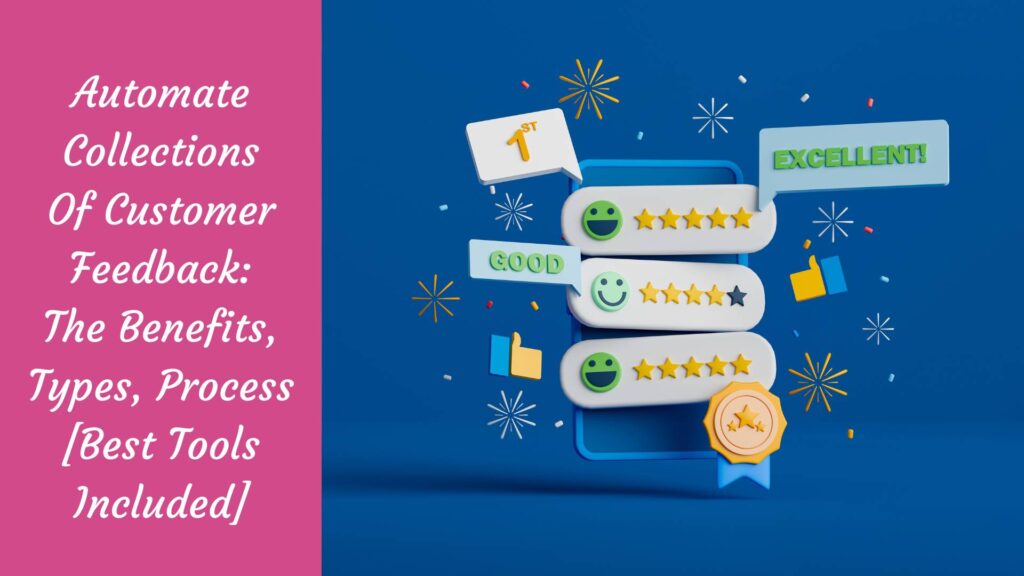In today’s fast-paced world, understanding what your customers think about your service or product can be the difference between success and failure.
Collecting customer feedback is crucial, but it’s often time-consuming and complex.
Are you struggling to keep up?
Fear not!
Our comprehensive guide dives into the benefits, types, and processes of automating customer feedback collection, presenting you with the best tools to simplify this vital task.
Discover how to effortlessly gather insights that propel your business forward, all in one place.
The Critical Role of Customer Feedback
Feedback from customers isn’t just nice to have; it’s the bread and butter that can make or break the success of a product or service. By tuning into what your users are saying, businesses can fine-tune their offerings to better meet the needs and wants of their target audience.

Directing Product Development
- Market Fit: Imagine launching a new app that you think is the next big thing. Without customer feedback, you might miss that users find one of its features confusing or unnecessarily complicated. Feedback acts as a compass, guiding the development to ensure the product fits the market correctly.
- Innovation: Take the classic example of Netflix’s shift from DVD rentals to streaming. Customer feedback highlighted a growing demand for streaming services. Netflix listened and innovated, leading them to dominate the streaming industry.
Enhancing Customer Experience
Feedback is gold when it comes to developing a customer experience that keeps folks coming back for more. Here are a couple of ways to do this:
- Refining the Journey: Through feedback, a company can discover that customers are dropping off at a certain point on their website. This insight drives changes for a smoother user experience, like simplifying the checkout process on an e-commerce site such as Amazon.
- Building Loyalty: When customers see their feedback leading to actual improvements, they feel heard and valued. This strengthens their relationship with the brand, increasing loyalty—a win-win for both the business and its customers.
The Limitations of Traditional Feedback Collection
While traditional methods of collecting feedback, like surveys or feedback boxes, have their place, they come with their own set of problems.
Time and Resource Constraints
- Manual Hassles: Collecting and analyzing feedback via old-school methods is like trying to drink a smoothie with a fork – it’s possible, but it’s unnecessarily hard work and very inefficient.
- Costly Endeavors: Deploying and analyzing manual surveys not only consumes a significant amount of time but also hog resources that could be better utilized elsewhere.
Inconsistencies and Biases
- Error-Prone: Human error is a result of manual processes. A misplaced form or a misheard comment can drastically skew the feedback received.
- Bias Introduction: When collecting feedback manually, it’s easy for subconscious biases to sneak in. For instance, an employee might unintentionally give more weight to comments that align with their own opinions, skewing the data.
Feedback, when harnessed and analyzed correctly, is a powerful tool for driving product development and enhancing customer experiences. However, traditional collection methods can introduce inefficiencies and biases that may muddle this valuable data. It highlights the necessity for businesses to evolve their feedback collection strategies, leveraging technology to automate and streamline these processes.
Embracing Automation for Feedback Collection

The Advantages of Automated Feedback Collection
Scalability and Efficiency
Automating the collection of customer feedback revolutionizes how businesses scale their insights acquisition without scaling their efforts linearly. Imagine serving thousands of customers across the globe – manually handling feedback would be like trying to fly a kite in a hurricane. Impossible, right? With tools like SurveyMonkey or Google Forms, businesses can deploy surveys that reach out to an expansive audience instantly, all while sitting back and monitoring the responses rolling in with minimal effort. This lean approach ensures that no customer’s voice is missed, providing a broad and representative sample of customer sentiment.
Real-Time Insights and Analytics
In the age of instant gratification, waiting weeks for feedback analysis is akin to sending a telegram in the era of WhatsApp. Automated feedback tools like Qualtrics offer the magic of real-time analytics, launching businesses into a reality where understanding customer feedback is as immediate as reading a message on your phone. This speed in turning raw data into actionable insights allows businesses to pivot, adapt, and innovate at the pace the market demands, ensuring they’re always a step ahead.
Types of Automated Customer Feedback
Surveys and Polls
Automated survey tools stand out for their effectiveness and efficiency when it comes to structured feedback collection. Platforms like Typeform not only make surveys painless to create but also enjoyable for users to complete with their interactive and visually appealing interfaces. This increase in engagement rates means businesses can collect more data, more accurately reflecting their customer’s opinions and experiences.
Social Listening Platforms
For a bird’s-eye view of what the world is saying about your brand, nothing beats social listening platforms. Tools like Brandwatch sift through the vast ocean of social media chatter to fish out relevant mentions, trends, and sentiments about your brand. This automated feedback collection method is invaluable for understanding public perception in real time, providing unfiltered insights that traditional surveys may not capture.
In-App Feedback Tools
Capturing the moment has a different connotation in the customer feedback world. In-app feedback tools like UserTesting allow businesses to collect feedback while the user is interacting with their product, offering context-rich data that isolated surveys can’t. Imagine knowing exactly what features your users were utilizing when they faced an issue or had a suggestion, allowing for pinpoint improvements. This immediacy and context specificity make in-app feedback an indispensable tool in the customer feedback arsenal.
In short, the magic of automation in feedback collection is like having a crystal ball, but with data-driven insights—it lets you see the present more clearly and predict the future more accurately. By leveraging these automated tools, businesses can harness the power of feedback to steer their ship with confidence in the competitive seas of today’s market.
Implementing Automation in Feedback Collection

Choosing the Right Automation Tools
Essential Features to Consider
Picking the right tools for automating your feedback collection can feel like finding a needle in a haystack. Keep your eyes peeled for:
- Integration Capabilities: Your tool should play nice with others. For instance, it should easily sync with your CRM or email marketing software (Mailchimp).
- Customization: One-size-fits-all is a myth. Look for tools that allow you to tweak every little detail to fit your brand and your needs.
- Ease of Use: If it needs a manual thicker than “War and Peace,” skip it. Your team and your customers will thank you.
- Analytics Power: What good is data if you can’t understand it? Ensure the tool offers insightful, easy-to-digest analytics.
Review of Top Tools for 2024
In the digital age, a few stars shine brighter in the feedback tool universe:
- SurveyMonkey: The go-to for surveys. Known for its robust features and flexibility.
- Zendesk: Not just for customer support. Their feedback tool is a gem for collecting and managing insights.
- Medallia: Takes customer experience to the next level with real-time feedback analysis.
Setting Up Automated Feedback Loops
Integration with Existing Systems
Seamlessness is the name of the game. Connecting your new automated feedback tools to your existing systems should not require an IT degree. Look for platforms offering straightforward APIs and plugins for integration. For example, integrating Feedbackify with your website or Zendesk with your customer service software can be as simple as a few clicks.
Crafting Effective Feedback Forms and Surveys
First impressions matter. Here’s how to make your surveys impossible to ignore:
- Keep it short and sweet. The less time it takes to complete, the better.
- Ask the right questions. Avoid yes/no questions and opt for scale ratings or open-ended questions for richer insights.
- Make it pretty. Use your branding, colors, and logos to make your survey visually appealing with tools like Typeform.
Analyzing Feedback for Actionable Insights
Leveraging AI for Data Analysis
AI isn’t just for sci-fi anymore. It’s your best friend when sifting through piles of feedback to find gold. Tools like MonkeyLearn use machine learning to analyze text responses, identifying patterns, sentiments, and even emerging customer needs you might not have noticed.
Closing the Loop with Customers
Feedback is a two-way street. Here are some ways to close the loop:
- Acknowledge every piece of feedback. A simple “thank you” goes a long way.
- Act on the feedback. Make changes based on what you learn and share updates with your customers.
- Make it personal. Customize your responses to show you really understand and appreciate their input.
Automating your feedback collection doesn’t mean losing the personal touch. With the right tools, integration, and approach, you can turn feedback into your roadmap for growth, ensuring your customers feel heard and valued every step of the way.
Top 5 Automated Collections of Customer Feedback Tools(5 pros and cons with top features)

Sure, breaking things down in plain English, here are the top 5 automated tools for scooping up that gold dust – customer feedback. I’ll give you the skinny on each, with what’s to love and what might make you pause, plus the killer features that set them apart.
- Pros:
- Totally Free: It doesn’t cost you a dime.
- Mad Easy to Use: If you can use a web browser, you’re golden.
- Super Flexible: Quizzes, surveys, or whatever you need.
- Seamless with Google Suite: Works like a charm with Sheets, Docs, etc.
- Unlimited Responses: Ask away without worrying about hitting a cap.
- Cons:
- Basic: Don’t expect all the bells and whistles.
- Limited Customization: What you see is pretty much what you get.
- No Built-In Analytics: You gotta sift through the data yourself.
- Top Features: Integration with Google Suite, easy collaboration, and it’s free.
- Pros:
- Looks Amazing: Seriously, it’s pretty.
- User-Friendly: Keeps your respondents engaged.
- Customizable: Make it match your brand.
- Integrations: Slack, Google Sheets, you name it.
- Insightful Reports: Get the lowdown without the legwork.
- Cons:
- Pricey: Free version is pretty basic.
- Overwhelming Features: Might be too much for small projects.
- Learning Curve: Takes a minute to get the hang of.
- Top Features: Beautiful forms, high engagement, and robust analytics.
- Pros:
- Versatile: Quizzes, opinion polls, or detailed surveys – it’s got you covered.
- Powerful Analytics: Makes sense of your data for you.
- Customizable: Tailor it to your heart’s content.
- Large Question Bank: Saves you from brainstorming questions.
- Good Integration: Plays well with others like MailChimp and Salesforce.
- Cons:
- Cost: Gets expensive for more features.
- Complexity: With great power comes a steeper learning curve.
- Response Limits: The free version puts a cap on your feedback.
- Top Features: Comprehensive analytics, question bank, and versatile survey types.
- Pros:
- Straightforward: Easy as pie to set up and use.
- Real-Time Feedback: Get insights the second they hit ‘send’.
- Fully Anonymous: Lets folks be brutally honest.
- Custom Feedback Forms: Tailor it to exactly what you need.
- Affordable: Won’t break the bank.
- Cons:
- No Frills: It’s pretty basic.
- No Built-In Analytics: You gotta do the number-crunching.
- Limited Integration: Doesn’t buddy up with other tools as much.
- Top Features: Real-time feedback, anonymity, and simplicity.
- Pros:
- All-In-One: Customer feedback, support tickets, and more.
- Powerful Integration: Works with a ton of other software.
- Scalable: Grows with your business.
- Automation: Makes following up a breeze.
- Strong Analytics: Understand your customers better.
- Cons:
- Costly: You get a lot, but you’ll pay for it.
- Complex: Might be overkill for simple feedback needs.
- Steep Learning Curve: Takes time to master.
- Top Features: Comprehensive customer service suite, strong analytics, and extensive integration capabilities.
Alright, that’s the roundup. Whether you’re strapped for cash, looking for beauty, after deep insights, or need something straightforward, there’s a tool here for you. Remember, the best tool is the one that fits your needs like a glove. Happy feedback hunting!
7 Best Practices and Pitfalls to Avoid

Maximizing the Impact of Automated Feedback
Personalization and Timing
To really grab your customer’s attention and increase engagement, feedback requests should feel like they’re coming from a friend, not a robot. Here’s how:
- Personalize your emails or notifications with the customer’s name and past interactions. For example, instead of a generic “We want your feedback,” try “Hey [Name], we noticed you just completed your first marathon using our app—how did it go?”
- Timing is key. Send feedback requests when the experience is fresh but not intrusive. A nudge right after the purchase with a simple “how did it go?” can work wonders compared to a cold email weeks later.
By integrating tools like Intercom for personalized messaging and scheduling platforms like Later to time your feedback requests perfectly, you can significantly increase response rates and valuable insights.
Ensuring Data Privacy and Security
Winning customer trust is crucial, especially when handling their data. Here’s what to do:
- Be transparent about how you’re using their data. A clear and concise privacy policy that’s easy to understand—no legalese.
- Secure their data with up-to-date technology. Use secure servers and encrypt sensitive information. Services like SecureLayer7 can help protect your data against breaches.
Promising and ensuring data privacy isn’t just good ethics—it’s good business. Customers will trust you more and be more willing to share their insights.
Common Pitfalls in Feedback Automation
Over-automation and Loss of Personal Touch
Reliance on automation can make feedback collection feel impersonal. Remember:
- Automation is a tool, not a replacement for human interaction. Follow up automated feedback requests with personal messages for any detailed responses. Tools like Slack allow your team to discuss feedback personally and decide on a human response.
- Share stories of how feedback led to real changes. A newsletter or blog post about updates based on customer input can humanize your brand.
Ignoring Qualitative Feedback
While quantitative data can be easier to analyze, qualitative feedback is where the gold nuggets of insight lie.
- Use natural language processing tools like Luminoso to sift through open-ended responses for themes and sentiments.
- Don’t dismiss the outliers. Sometimes, the most unique insights come from feedback that doesn’t fit the mold.
Automating feedback collection isn’t about setting it and forgetting it. It’s about leveraging technology to gather insights while maintaining a personal, trustworthy relationship with your customers. By balancing automation with a genuine human touch and respecting customer data, you can maximize the effectiveness of your feedback processes and drive meaningful improvements in your product or service.
FAQs
What are the main benefits of automating the collection of customer feedback?
Automating customer feedback collection offers several key advantages. Firstly, it significantly improves response times by enabling real-time feedback collection and analysis. This immediacy helps businesses quickly identify and address customer concerns or negative experiences. Secondly, automation allows for the customization of survey forms, ensuring that the feedback collected is relevant and valuable. Lastly, automation aids in easily identifying problems in data collection and analysis, ensuring more accurate and actionable insights (Source: AIMultiple).
Can automating customer feedback collection lead to better organization and improved cash flow for businesses?
Yes, automating customer feedback collection contributes to better organization and improved cash flow in several ways. By streamlining the feedback process, businesses can more efficiently organize customer insights, leading to quicker decision-making and implementation of improvements. This efficiency can enhance customer satisfaction and loyalty, indirectly contributing to improved cash flow by fostering repeat business and reducing customer churn rates. Additionally, automation reduces the incidence of late and failed payments by ensuring timely communication and follow-up with customers (Source: Kubra).
How does list segmentation work in automated customer feedback collection, and why is it important?
List segmentation in automated customer feedback collection involves categorizing customers based on specific criteria such as their purchasing behavior, demographics, or interaction history. This segmentation allows businesses to tailor their feedback requests and communication more effectively, ensuring that the right message reaches the right customer segment. The importance of list segmentation lies in its ability to increase engagement rates, as personalized messages are more likely to resonate with customers, thereby improving the quality and quantity of feedback collected (Source: PayKickStart).
What types of customer feedback can be automated, and how do these methods benefit businesses?
Several types of customer feedback can be automated, including surveys and polls, social media monitoring, and in-app feedback tools. Automating these feedback collection methods benefits businesses by providing a scalable way to gather insights across various customer touchpoints. It also offers the advantage of collecting feedback in real time, allowing businesses to quickly identify and act on trends, issues, or opportunities. Furthermore, automation enables more personalized and context-rich feedback collection, enhancing the quality of insights gained (Sources: UserPilot, WotNot, Retently).
How does automating customer feedback collection transform CRM strategies, and what efficiencies does it introduce?
Automating customer feedback collection transforms Customer Relationship Management (CRM) strategies by making them more data-driven and responsive. Efficiency and time savings are among the most significant advantages, as automation eliminates routine tasks such as manual data entry and lead tracking. This allows businesses to focus on analyzing feedback and developing strategic responses to enhance customer relationships. Additionally, automation supports more effective segmentation, personalized communication, and predictive analytics, enabling businesses to anticipate customer needs and preferences more accurately (Source: FasterCapital, VersaPay).
Conclusion
The strategic automation of customer feedback collection is an integral component of maintaining and enhancing customer relationships in today’s digital landscape. It offers a plethora of benefits, including improved response times, personalized communication, and actionable insights, which directly contribute to better organization, increased cash flow, and a more data-driven CRM strategy.
However, to harness the full potential of feedback automation, businesses must balance technology with a human touch, respecting and valuing every piece of feedback they receive. By doing so, they not only streamline their processes but also forge stronger, more personal connections with their customers.
This balance between technology and human interaction paves the way for insightful, actionable feedback, driving meaningful improvements in products and services. For businesses looking to deepen their understanding and maximize their use of customer feedback automation, we invite you to LEARN MORE about best practices, innovative tools, and success stories.

10+ years experience in Marketing and Operations

I sincerely enjoyed what you have produced here. The design is refined, your authored material trendy, yet you appear to have obtained a degree of apprehension regarding what you aim to offer next. Certainly, I shall return more frequently, just as I have been doing almost constantly, provided you uphold this incline.
I truly relished the effort you’ve put in here. The sketch is stylish, your authored material chic, however, you seem to have developed some anxiety about what you intend to deliver subsequently. Assuredly, I will revisit more regularly, akin to I have nearly all the time, in the event you maintain this rise.
I genuinely enjoyed the work you’ve put in here. The outline is refined, your written content stylish, yet you appear to have obtained some apprehension regarding what you wish to deliver thereafter. Assuredly, I will return more frequently, akin to I have almost constantly, provided you maintain this climb.
I genuinely relished what you’ve produced here. The outline is elegant, your written content trendy, yet you appear to have obtained some anxiety regarding what you wish to deliver thereafter. Assuredly, I will return more frequently, akin to I have almost constantly, provided you maintain this incline.
I genuinely savored the work you’ve put forth here. The outline is refined, your authored material trendy, however, you seem to have obtained some trepidation about what you wish to deliver next. Assuredly, I will revisit more regularly, akin to I have nearly all the time, provided you maintain this upswing.
I genuinely enjoyed the work you’ve put in here. The outline is refined, your written content stylish, yet you appear to have obtained some apprehension regarding what you wish to deliver thereafter. Assuredly, I will return more frequently, akin to I have almost constantly, provided you maintain this climb.
I sincerely appreciated the effort you’ve invested here. The sketch is tasteful, your authored material chic, however, you seem to have developed some uneasiness about what you aim to offer henceforth. Certainly, I shall revisit more regularly, just as I have been doing nearly all the time, should you uphold this climb.
Nice advice! Getting high-quality leads isn’t easy. Personally, I’m always looking for new
lead generation methods.
This blog gives you access to newly released cloud
marketing tools and apps.
No opt-in required!
Check out the website at the link below:
https://www.otos.link